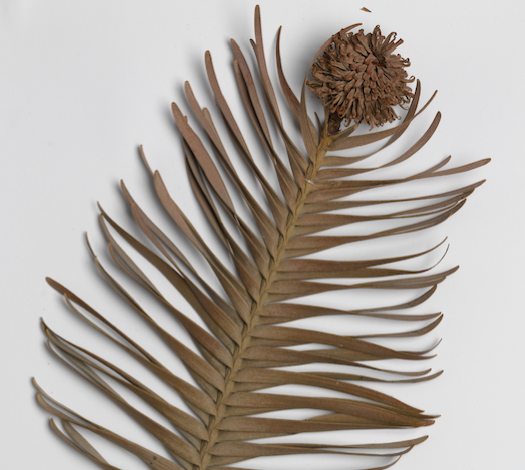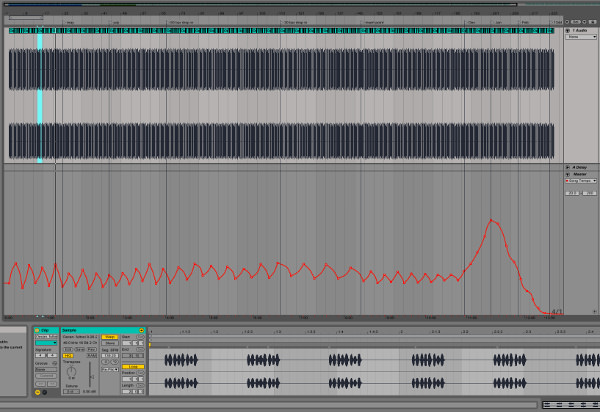
seed in space/sound in time
by JOSH WODAK
- View Josh Wodak's Biography
Josh Wodak is an artist and Lecturer in the Faculty of Art and Design, University of New South Wales.
If a Seed Falls in a Forest: Sounding out Seedbanks to Sonify Changing Climates
Josh Wodak
Figure 1 - Wollemia Nobilis, Accession Number MELU G113379a, University of Melbourne Herbarium
Accession Number MELU G113379a lies in a drawer in the archive of the University of Melbourne Herbarium (see Figure 1). G113379a is also known by its generic name Wollemi Pine. Or by its taxonomic name Wollemia Nobilis. Or by its more correct taxonomic category in the family Araucariaceae as it is neither a pine tree nor a member of Pinaceae, the family of pine trees. When obtained from Wollemi National Park the tree branch was chlorophyll green. Now it lies in uniform beige brown. Flat pressed in the herbarium archive. By any other name it would look as sweet. At its tip is the head of seeds that would have gone to ground for the next generation of trees, had it not been acquired by W. G. Jones, K. D. Hill and J. M. Allen for their formal taxonomic submission in 1995, the year after they discovered the species.
G113379a has also been rendered silent - no creeks and groans of branches swaying back and forth in the wind. No cracking sound of twigs breaking off. No splitting sound of seed pods opening when germinating in the soil. And no sound of companion species of birds or insects, enmeshed in co-dependent existence with Nobilis. Those sounds are consigned to silence in herbarium and seedbank archives, much like the sound of a tree falling in a forest when no receptors are around. How then can the collections of seed and sound archives be animated, to attune our sensibility toward the fragility and tenacity of species in changing climates? What stories can G113379a speak to - of the species Nobilis and of evolution and extinction at large? And, how may animating a seedbank archive through sound speak to evolution, and its twin, extinction?
At play here are two interwoven stories: this essay and its twin, the artwork seed in space/sound in time.
While the work was commissioned from the author for the Creative Ecological Investigations: Art and Herbarium exhibition at Carlton Connect, this article describes the online 2-channel version:
Both stories situate seeds in space, and sound in time. Over the longue durée of geological time, coming to a near abrupt end with the critically endangered status of Nobilis. Over the vast space of continental drift across the Earth surface and onwards to low earth orbit, coming to an abrupt end in Mount Annan Seedbank in NSW. Our story begins way back when...

Figure 2 - Tree of Life sketch, Charles Darwin 1859
Way Back When
Picture a line that traces the ancestral lineage of a family tree. This line is in the manner of Charles Darwin's Tree of Life sketch of 1837 (Darwin 1859), where a mosaic of lines and nodes illustrate his schema of evolution and extinction (see Figure 2). Now trace the number of generations of Nobilis, going back from G113379a through every prior generation. Each node represents one generation, connected by each segment of line. The lines would extend back through approximately 400,000 generations, as the species has existed for 200,000,000 years. Since Nobilis speciated from its own parent species, its DNA has been continuously replicated not only through time, but also through space. The travelled space extends from across the ancient supercontinent of Gondwana, as Nobilis was endemic across vast swathes of the supercontinent. The space then begins to move - not just from the changing dispersion of Nobilis across Gondwana, but because over the longue durée you will find continents drifting, separating and re-attaching. Nobilis surfed the surface of the supercontinent and its separation into new continents by the breaking up of tectonic plates. The journey terminus is the current resting point on the Australian Plate. All in all, travelling at an average speed of 5 cm per year for 10,000 kms over 200,000,000 years.
This ancestral line is not simply a thin black line tracing the journey from Gondwana to Australia: the line is a map. Of geographic dispersion in space over time. The shape traced goes from the wide swathe of Nobilis that existed across Gondwana to today, through ebbs and flows of global environmental changes that periodically pushed and pulled the tolerance thresholds that a diminishing population of Nobilis could withstand. Thresholds of tolerance are the ability for any lifeform to withstand environmental change: from rainfall and temperature through to continental drift and uplift.
If projecting this map onto the Earth from the height of the International Space Station 400 kms above, the temporal shape of Nobilis' geographic distribution would look like a funnel that proceeds to rapidly diminish down to the eye of a needle. As it draws toward the present, the funnel terminates in the only spot on Earth Nobilis are thought to exist in the wild: within a steep, narrow gully 150 km north west of Sydney.
Only discovered in this gully in 1994, Nobilis has become a totemic species for conservation biologists, due to both its tenacity and fragility. The tenacity owes to having survived through the euphemistically termed ebbs and flows of global environmental change, including mass extinction events when Nobilis speciated 200 million years ago, and another 65 million years ago which ended the age of the dinosaurs. Such evolutionary longevity is tenacious - on average new species go extinct during the 10 million years following speciation. Yet while most contemporaneous species were rendered extinct through the unfolding cataclysms of periodic environmental upheaval, Nobilis continuously reproduced throughout. A continuous sound cycle of elder generation trees falling, and emerging generation seedlings germinating.
The twin to such evolutionary bravado is that Nobilis is on the precipice of extinction. The fragility owes to the genetic homogeneity of the only known remaining vessels of this DNA heritage, numbering less than 100 trees residing in one narrow gully. Nobilis is both a relictual population and taxon. That is: the gully refugia is the sole preserve of a population which used to exist far and wide across the Earth. And this sole preserve is also the only living members of its genus. Following classification in 1998 as Critically Endangered on the International Union for Conservation of Nature's Red List of Threatened Species, a pathogen that moved through space on the heel of a bushwalker since decimated a third of this wild population.
The interplay between tenacity and fragility, endemic to all evolution and extinction, now plays out in challenges without precedent in this history of this planet. This time Nobilis is up against the environmental conditions of the Anthropocene. One measure of this now all-too anthropogenically induced geological era is the currently unfolding sixth such mass extinction event since complex multicellular life first evolved 570 million years ago. Yet such an onerous benchmark is just a fragment of the full gamut of extinction threats facing the world-of-life. Relative to the entire geological history of this planet we are now in a "no-analogue state" (Crutzen and Steffen 2003) which is begetting a "no-analogue future" (Williams et. al. 2013). There are no inferences for the "no-analogue future" unleashed by the Anthropocene.
Nevertheless, we still map, model, predict and ponder life at large. Though no instance of the past is literally any future guide any more.
Normative climate modelling though is still beholden to ever greater refinement of models for projected climatic shifts over the remainder of this century. According to this normative framework, if you are a tree, you would want to move away from the equator at an average of 1.15 metres per day to continue to exist in your current baseline temperature. That is the figure calculated by mapping the average tolerance threshold of trees across the world relative to projected rates of anticipated climate change for the remainder of the 21st century (Loarie 2009). If you are a Wollemi tree, you can not move further away from the equator than the narrow gully as there is no climbing out of the sheer cliff face on all sides. Just as there is no digging oneself out of a hole. To put the move away from the equator into perspective: as the Indian-Australian Plate is moving toward the equator at 7.5cm per year, trees and plants in Australia would have to move just that bit faster south to offset the northward drift of the continent.
If you are a Wollemi seed, you could however move much further by hitching a ride - say in a bird's stomach or the collection pouch of a conservation biologist. So it is in 2008 that 100 Nobilis seeds are collected from Wollemi National Park, where they begin a journey across the length and breadth of the Earth and into Low Earth Orbit. From the time and space of Gondwana 200,000,000 years ago to Wollemi National Park in 2008, Nobilis DNA travelled the 10,000 km at an average rate of 5 cm per year. Unlike their ancestors, the sibling seeds picked that day in 2008 are scattered across and above the globe. Over the 12 months following collection, these 100 seeds are separated into control samples that are sent on the horizontal axis to Mount Annan Botanic Garden Seedbank, 50 kms away. On the vertical axis, 23 of the seeds are sent to the International Space Station, to orbit at 28,000 km per hour for six months, where they travel 12,230 times the total distance from Gondwana to Wollemi National Park.
These seeds are dispersed to Mount Annan and the ISS under the auspices of the Seeds in Space project - the first time Australian native seeds are sent into space. For this experiment, NASA and the Sydney Botanic Gardens Trust send 2,500 Golden Wattle, NSW Waratah, Flannel Flower and Wollemi Pine seeds to the ISS to explore the effects of microgravity and ionising radiation on the seeds. They also test the viability of a 'space seedbank' as an off-world adjunct to terrestrial seedbanks. Particular attention is paid to the notoriously hardy Golden Wattle to see whether it can be successfully propagated on a future moon or Mars colony. On board the ISS the 2,500 seeds are kept in the sock drawer of NASA astronaut Gregory Chamitoff. He takes them on board and sleeps with them by his bed for six months, before returning them to Mount Annan to test if and how they will germinate.
Diversification After Decimation
A seed shell is the permeable membrane across which it exchanges matter and energy with its surrounding environs. Like all organisms, a seed continuously redefines the tolerance thresholds of exchanging matter and energy across this membrane, such as the surrounding temperature, hydration and chemical constitution. Nobilis seeds sitting in the gully presently experience a temperature range when on the tree or the ground of 14-38°. Those sent to Mount Annan and the ISS are subject to a much wider range of temperatures, given the combination of immersion in controlled laboratory environments, where they are deliberately exposed to temperatures ranging from 18° to +45°, as well as uncontrolled exposure to temperature variation during transit by truck, train, airplane, and, in the case of ISS, rocket ship. Upon return to Earth, the space-trodden seeds are placed alongside their siblings that remained at Mount Annan for the duration. Both sets are brought back to room temperature for germination, so the scientists can compare differences in growth morphology between those that stayed versus those that left Earth. No Nobilis germinate - due to unintended side-effects of being sterilised for the drying process for the ISS.
While the captured seeds' trajectories end in dormancy, propagation, or death by sterilization within a seedbank, my project resounds the turbulence of the active phases of the Seeds in Space project. seed in space/sound in time recreates the journey of the Nobilis seeds by mapping the temperatures three particular seeds experience over the 12 months of the experiment. The work is 12 minutes in duration - every second of sound equals 12 hours of the experiment. I want to reanimate the dead specimen lying in the herbarium draw - as if to inject it with green chloroform that courses through the leaf capillaries. I want to draw on and from the emotion and emotional histories inherent to an archive. And to give voice - simulated, modified, manipulated - to an affective rendering of the experiment Nobilis was subject to. This act of giving voice aims to evoke the interplay between tenacity and fragility, evolution and extinction, archives and memory, animation and simulation. What if we could hear this interplay between the artifice of control - through conservation biology - versus natural turbulence? Pitting the artificial temperatures experienced in two other seeds' journeys versus the 'natural' temperature of one wild seed left behind in the gully.
To translate this exploration into sound, daily temperatures for each seed are mapped to a corresponding sound whose pulse rate and pitch is modified according to the temperature at that time. The three sounds are all of the Snowy Tree Cricket (Oecanthus Fultoni) from North America. Each seed has a Fultoni watching over its journey - as a proxy for data loggers which mechanically record all temperature and humidity changes the seeds experience in the experiment. Fultoni is an apt proxy, as the cricket constantly monitors its surrounding temperature and adjusts its chirping pulse rate and pitch according to any ambient temperature changes. Due to the fidelity of its ambient temperature derived pitch and frequency changes Fultoni is colloquially referred to as the 'thermometer cricket'. I also chose this cricket due to the aesthetics of its pulse. In his 1833 novel The Canterbury Pilgrims Nathaniel Hawthorne described the "audible stillness" of Fultoni singing "in full choir upon the wind" and likened the experience to "if moonlight could be heard, it would sound just like that." I co-opted Hawthorne's unrestrained romanticism, to apply it to our Anthropocene era: 'if temperature change could be heard, it would sound just like that' in seed in space.
To evoke the act of subjecting the seeds to multiple artificial processes (including scientific collection, dispersal, experimentation and climate controlled conditions), I wove the fabric of sounds into and around one another. This was done according to another stricture of 'control', subject to inherent turbulence. The tapestry created is driven by a high fidelity to real time temperature data, which solely drives the pitch, frequency and tempo changes of the looped sample of Fultoni singing "in full choir upon the wind." Seeding control to the temperature data, rather than my compositional preferences, was undermined by the inherent turbulence of the sound sample itself. Fultoni chirps are composed of varying patterns of five versus eight staccato utterances. So speeding up and slowing down the looped sample creates all manner of micro polyrhythms within each chirp, between preceding and succeeding chirps of the same voice, and then multiplied by the polyphony of all of this happening simultaneously between all three voices.
Voice 1 is the in situ seed, which sets the benchmark for the 'natural' climate experienced by an uncollected seed. Voice 2 and Voice 3 are the artificial temperatures experienced by the two other seeds at Mount Annan and the ISS respectively. In the 2-channel version the left maps the Mount Annan controlled seed temperature and the right maps the partially controlled temperature for a seed on the ISS. The center channel is the temperature for an uncollected seed still in Wollemi National Park. The 3-channel installation is configured as an equilateral triangle between three speakers. The Wollemi National Park channel is positioned on the floor, left to an audience. The Mount Annan channel is positioned on the floor, right to an audience. Directly above the middle of the two floor speakers is the channel representing the ISS. In both 2- and 3-channel versions the sound channels all start in unison, as the sonic journey for all seeds originates at the Wollemi National Park collection point. The voices then progressively deviate in and out of frequency with one another, as the seeds undergo their various journeys and destinations.
The work is in four sections, according to the notional four seasons of a year. The outdoor seed follows the 'natural' seasons, while the seedbank and space station artificial climates follow one another closely, in line with the scientists' attempt to keep these seeds in identical controlled climates. In this trio of voices the relative oscillation of such 'natural' variability poses a counterpoint to the 'artificial' homogeneity the ISS and Mount Annan seeds were subject to. The progressive deviation between voices is in counterpoint to the arbitrary construct of 'seasons' themselves, both in the cultural imaginary and in music, exemplified by Vivaldi's The Four Seasons. Say, an acoustic enactment of Mathilde Fallot's Golab Waminrg poster, where the four seasons borrow letters from one another, to be misspelt as "sprumer sumumn auter winting" (see Figure 4). The pitch, frequency and tempo cacophony in seed in space amplify the breakdown of distinct seasonality as per the current "no-analogue state" (Crutzen and Steffen 2003) and "no-analogue future" (Williams et. al. 2013) of Earth System processes.
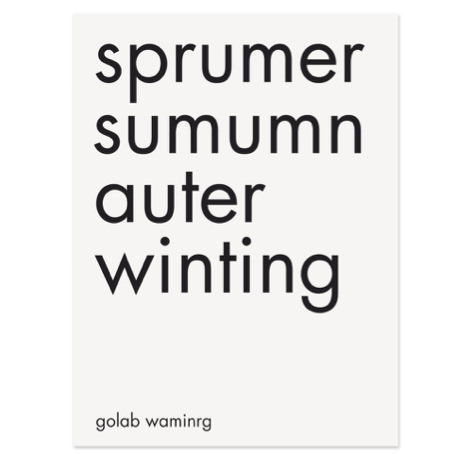
Figure 4 - Golab Waminrg poster, Mathilde Fallot (2007)
To enact the progressive intermingling between 'seasons' and the three voices, seed in space draws on the compositional techniques of phrasing and phasing, as developed by minimalist composer Steve Reich. In these techniques sound patterns shift into and out of phrase and phase with one another, according to stages in the experiment where control seeds on Earth are subject to the same conditions as those in space, to compare and contrast the effects of this temperature exposure on the germinating capacity of the different seeds. When ISS and Mount Annan seeds are both kept at 25° the pulse rates of their corresponding cricket sample are in phase. When the Mount Annan seeds are cooled down to 8° for storage, or when the ISS seeds are transported by airplane to Cape Canaveral, their pulse rates are of phase - being much slower/lower or faster/higher in rate/pitch than the other.
Science as Culture
Resounding - rather than recreating - the original experiment was made possible by generous correspondence, advice and data from the five scientists who undertook the Seeds in Space experiment. Three scientists from Sydney Royal Botanic Gardens and Domain Trust - Dr Penny Farrant, Dr Catherine Offord and Dr Peter Cuneo - collaborated with Leahwyn Seed, Seed Technology Officer, National Parks and Wildlife Service, to provide Professor Gregory Chamitoff with the seeds and to set up the control experiments on earth, with Chamitoff responsible for shepherding, nursing and returning the seeds to and from the ISS.
In addition, I manually reconstructed proxy data for Bureau of Meteorology (BoM) temperatures for Nullo Mountain Weather Station, the source closest to where the seeds were collected. Data loggers accompanied the seeds in space, yet a technical failure meant they did not record the temperatures. So, to reconstruct ISS temperature records I consulted a range of technical manuals which specify the highly controlled temperatures abroad. Travel to and from Wollemi to the ISS was also manually reconstructed from freight company manuals and technical specifications about climate controlled transport.
The three sources of data - BoM, Mount Annan and technical reports for freight and the ISS - were combined into a spreadsheet of average weekly minimums and maximums for each seed over the 52 weeks (see Figure 4). These 52 data points formed the 'score' for each voice.
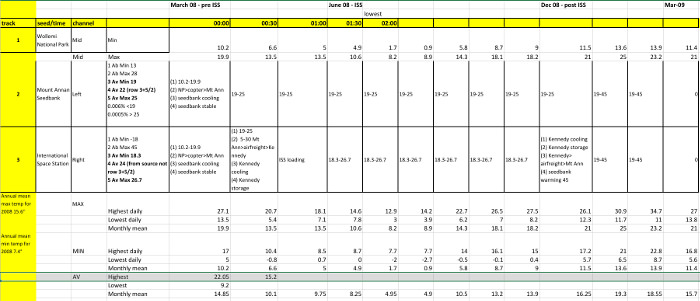
Figure 4 - Screenshot of the spreadsheet showing data sources and values that determined the modulation of the sound samples
These values were then converted in Ableton Live, a Digital Audio Workstation, to inflect the Snowy Tree Cricket playback speed and pitch according to the corresponding temperature data (see Figures 5, 6 and 7).
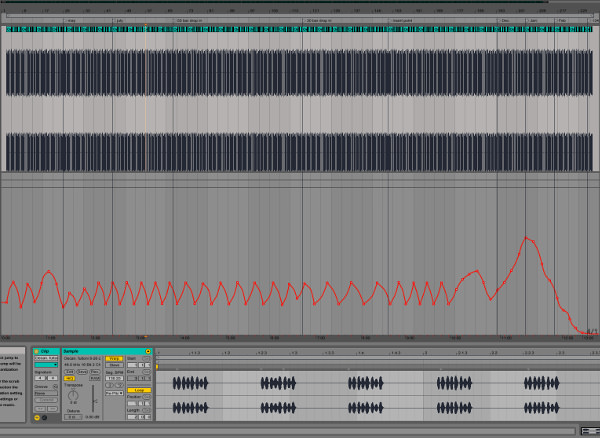
Figure 5 - Compositing the International Space Station (left stereo channel)
Figure 6 - Compositing Mount Annan Seedbank (right stereo channel)
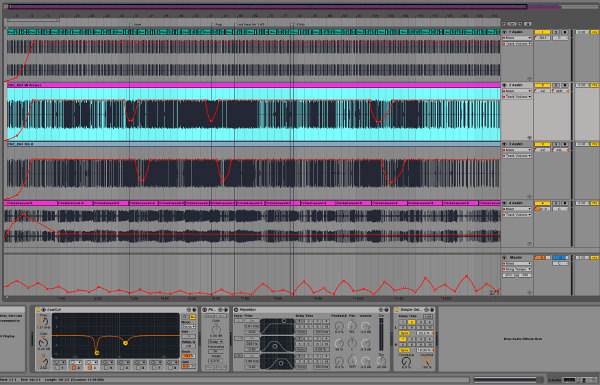
Figure 7 - Compositing all three channels/voices\ bottom row showing the more dynamic temperature changes in Wollemi National Park
Mapping: Data to Sound
Western music scores are based on Cartesian schema: time runs along the x-axis and pitch along the y-axis. These axes can alternatively be used to map chronology and temperature respectively. Sounds then become sonifications of value variance of a phenomenon, such as temperature, where change in pitch over time articulates a corresponding change in temperature. seed in space draws on such rendering of climate change through sound, including recent sound art and prevalent data sonification approaches (Ballora 2014; Philpott 2016; Polli 2006).
In 2013, US composer and performer Paul D. Miller released Of Water and Ice based on climate change data and his travels in Antarctica; marine geologist and geophysicist Marco Tedesco and musicologist Jonathan Perl, both from City College of New York, released their Greenland Melt Music which sonified their data of the melting Greenland ice sheet; and Daniel Crawford, a geography and environmental science student at the University of Minnesota, composed and performed A Song of Our Warming Planet. Crawford's work used analogue data-sonification of annual temperatures from 1880 to 2012 to reveal climatic warming trends over this period. He sourced the data from NASA's Goddard Institute for Space Studies in collaboration with professor of geography, Scott St. George, in a similar manner to how Greenland Melt Music was produced through a collaboration between a musicologist and scientist.
A Song of Our Warming Planet maps the temperature value for each year as a 1:1 signal:noise ratio, such that each temperature has an invariable corresponding pitch, with each year played for equal durations as crotchets in 4/4 time. The choice to use 1951-80 as the baseline, and to start by depicting 1880 means that the original cello baselines are progressively supplanted by higher pitched lines as the chronological rise of global warming becomes increasingly pronounced over the two minute composition. Setting the historic state-date earlier, such as at 1400, yet still ending in 2012, produces a distinctly different sonification of climate change. Julio Friedmann, chief energy technologist at Lawrence Livermore National Laboratory, who also trained as a classical composer, sonified this 1400-2012 data in his 2013 work Fiddling a Warming Tune. In this work a violin plays a contrast stream of semiquavers in 4/4 time, with one note representing four years, resulting in the 600 years of data being relayed over the 24 second duration of the work.
These approaches to sonifying climate change isolate a facet of a data-set in order to highlight a discernible trend. This generally denotes a rise in pitch to connote increases in global warming over a period sufficient for differentiating natural variability from anthropogenic climate change. In contrast, seed in space does not seek to reveal a warming trend, as 12 months is too short to discern any climactic patterns. Instead, average weekly lowest and highest temperatures were used to derive 52 data points for each voice. The pitch and frequency changes of Fultoni's chirping broadly follow the trajectory of a day: from lowest pitch and frequency at dawn, to highest in the late afternoon, and back to a mid-range around dusk. To let Fultoni's voice through, seed in space data points are thus about arcs and trajectories, ebbs and flows between weekly highs and lows. From the Lowest Average Temperature in Week 1, to the Highest Average Temperature in Week 2, to the Lowest Average Temperature in Week 3, and so forth.
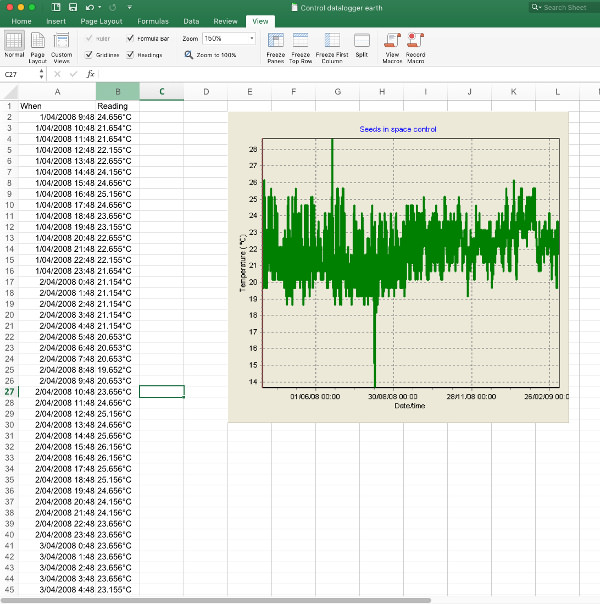
Figure 8 - Screenshot of Mount Annan control data logger of temperatures for the Wollemi Pine over time
Conclusion: Cold Comfort
The Fultoni recording cricket comes from another archive. Macaulay Library, in the Cornell Lab of Ornithology, is the largest archive of sounds of the world-of-life. This is where we go to hear what now extinct species sound(ed) like when they breathed life. And yet, like Accession Number MELU G113379a lying in a drawer in the University of Melbourne Herbarium, what is it that gets animated when we click on one of the millions of field recordings or photographs from such inventories of What Once Was? Beyond 'mere' pathos from listening to or viewing archives of precarity, the specter of extinction looms over natural collections.
Macaulay Library Catalogue Number 16209 is a recording of the huia, a native Aotearoa bird, as sung by the Māori man Henare Hamana. The recording of Hamana singing male and female huias calling to each other was made in 1952. Hamana drew on his own archive - his memory - having "learned the song in his youth from lingering birds on the eve of their extinction" (Warren 2015). In "Learning Extinct Birdsong in the Anthropocene: Huia Echoes" Julianne Lutz Warren draws these threads together: fragility and tenacity, evolution and extinction, archives and memory, animation and simulation. She writes: "what you are hearing is this call and response song of an extinct bird, as echoed from memory by human voice, as echoed, minus the interviewer's narration, by machine, continually looping - beginning, middle, end, beginning - into your head" (2017). While the bird went extinct during adult Hamana's lifetime, his recording animates what is otherwise yet another silent species that is no more. Artifice, machines, memory, simulation - so to with seed in space as a proxy vigil for the plight of Nobilis at the hands of conservation biology experimentation.
A natural sound archive is a recording of What Once Was - each utterance coming from a deceased individual. Others from a ceased species. In contrast, a seedbank aims to offer a bulwark against extinction - by tending seed stockpiles of current genetic heritage to form an arsenal of future potential biodiversity. To fulfil this aim seedbanks encase the ongoing existence of precarious species, exemplified by Nobilis, in artificially controlled temperature, moisture and humidity. This artificial environmental homogeneity stands in direct contrast to the rapidity and turbulence of contemporary environmental upheaval being unleashed on sibling seeds that remain outdoors. Nobilis has ceaselessly danced between fragility and tenacity for 200,000,000 years. Those alive today bear witness to the uninterrupted success of this dance.
Yet it is a dance that did not push either extreme, of fragility or tenacity, to a terminal end. The extreme end of the former yields extinction. The extreme end of the later yields evolution. Somewhere in between is ongoing survival: retaining sufficient genetic homogeneity between all members of a species - without necessarily evolving. seed in space offers us a way to listen to three representatives of survival over such a longue durée. Three Nobilis members caught up in the dance between fragility and tenacity, evolution and extinction, archives and memory, animation and simulation. The Seeds in Space experiment is when their dance moves becomes artificial, mechanical, and controlled - seeds on a space ship to probe what their tolerance thresholds are toward off-world environmental conditions. Nobilis has self-evidently gotten by without probing its tolerance thresholds to microgravity and ionising radiation. It would seem that we would like to put it to its limits, to know if its uninterrupted progeny can be stored in cold comfort off world while back down on Earth we push life to its limits, far and wide.
Launching off from Earth again, the Voyager Space Craft displayed the following message, encoded into a golden record plastered to its exterior. The first such declaration of sentiments sent into deep outer space, which, 40 years later, carry a greater weight than gravity itself:
This is a present from a small, distant world, a token of our sounds, our science, our images, our music, our thoughts and our feelings. We are attempting to survive our time so we may live into yours.
- President Jimmy Carter, July 29, 1977
Works cited
Ballora, M. "Sonification, Science and Popular Music: In search of the 'wow'." Organised Sound, 19(1) (2014): 30-40. Print.
Clark, N. Inhuman Nature: Sociable Life on a Dynamic Planet. London: SAGE. 2010. Print.
Crutzen, P. and Steffen, W. "How Long Have We Been In The Anthropocene Era? An Editorial Comment." Climatic Change, 61, 253. PDF
Darwin, C. On the Origin of Species by Means of Natural Selection, Or, The Preservation of Favoured Races in the Struggle for Life. London: J. Murray, 1859. Print.
Hawthorne, N. The Canterbury Pilgrims. Booklassic, 2015. Print.
Jones, W.G.; Hill, K.D.; Allen, J.M. "Wollemia nobilis, a new living Australian genus and species in the Araucariaceae." Telopea, 6 (2-3) (1995): 173-6. Print.
Loarie, S., Duffy, P., Hamilton, H., Asner, G., Field, C. and Ackerly, D. "The velocity of climate change." Nature, 462(7276), 1052-1055. Print.
Philpott, C. "Sonic Explorations of the Southernmost Continent: Four composers' responses to Antarctica and climate change in the twenty-first century." Organised Sound, 21(01) (2016): 83-93. Print.
Polli, A. "Heat and the Heartbeat of the City: Sonifying Data Describing Climate Change." Leonardo Music Journal, 16 (2006): 44-45. Print.
Williams, J., Blois, J., Gill, J., Gonzales, L., Grimm, E., Ordonez, A., Shuman, B. and Veloz, S. "Model Systems for a No-Analog Future: Species Associations and Climates during the Last Deglaciation: No-Analog Species Associations and Environments." Annals of the New York Academy of Sciences (2013): 29-43. Print.
Warren, L. "Hopes Echo." The Poetry Lab of The Merwin Conservancy, 2 November 2015, Web.
"Learning Extinct Birdsong in the Anthropocene: Huia Echoes" in Gregg Mitman, Marco Armiero and Rob Emmett (eds.) Anthropocene Remains. Chicago: University of Chicago Press, 2017. Print
